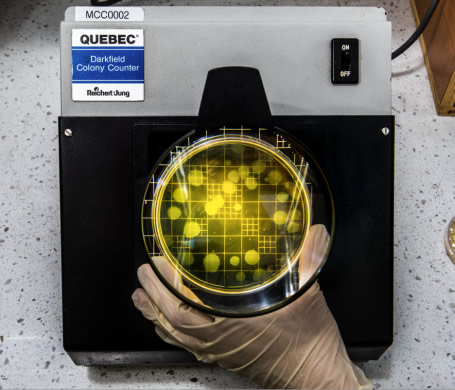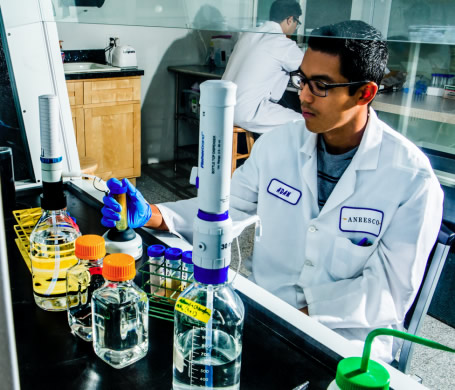
What’s The Matter With California Cannabis?
The greatest threat standing in the way of California’s march toward legalized marijuana isn’t Attorney General Jeff Sessions or Big Pharma. It’s the cannabis industry itself. Proof positive is hidden behind the glass-and-concrete walls of a low-slung building on an otherwise nondescript block of warehouses and auto body shops in Hunters Point.
It was here, where Anresco Laboratories has been testing imported seafood for the FDA since 1982 and, more recently, marijuana, that workers in white lab coats recently confirmed what many within the cannabis world have known for years: Much of the roughly $1 billion in cannabis sold in California’s 1,000-plus dispensaries every year is dirty. At least that’s what workers at Anresco found when they were asked to test buds, edibles, and concentrates entered in the competition at last August’s HempCon, one of several such trade shows. Some 80 percent of the product entered came back tainted with mold, pesticides, and harmful solvents. The dirty pot wouldn’t have been allowed on dispensary shelves in Colorado or Oregon, where marijuana must undergo quality-control testing before entering the legal market, and it certainly won’t pass muster when California adopts its own controls in January—expected to be even stricter than those in other states.
All of which means that it’s up to growers to invest in cleaner—and necessarily more expensive—cultivation practices to avoid being turned away from California’s dispensary shelves. And they’ll need to do it in a hurry. Until then, it’s buyer beware. The marijuana legalization era has just begun, and its first major challenge has already emerged. Here, a guide to the crud that’s turned up in California cannabis.
PESTICIDES AND FUNGICIDES
Risky products: Cannabis extracts
Potential health problems: Reproductive toxicity, cancer
It’s just a weed, but the cannabis plant can be a tricky mistress. An untimely bout of powdery mildew can render an entire crop worthless; many a plant has survived that plague only to fall victim to a pestilence of spider mites. For a commercial grower, the allure of chemical aids is hard to resist. That means pesticides are practically ubiquitous. About 70 percent of the cannabis Anresco tested that was intended for the California marketplace failed to meet pesticide screening standards currently in place in Oregon. One common contaminant is myclobutanil, sold under the brand name Eagle 20. Marijuana tainted with myclobutanil has already sickened consumers in Canada, where the federal health ministry regulates medical cannabis. Of particular concern are oil-based marijuana concentrates, made from trimmings. “We’ve seen pesticide levels 1,000 times higher in concentrates than what we might normally find in foods,” says Anresco’s Kyle Borland.
MOLD, FUNGI, AND BACTERIA
Risky products: Cannabis flower
Potential health problems: Lung infections, cardiovascular issues

Marijuana by itself hasn’t killed anyone, but a fungus found on some medical cannabis may well have. Researchers suspected a weed link when several cancer patients at UC Davis Medical Center developed rare lung infections—and one died—after smoking or vaporizing medical marijuana. And sure enough, a review of dispensary-bought pot revealed the fungus on numerous samples sold in Bay Area dispensaries. Mold is a particular risk to the immuno-compromised, a serious consideration given marijuana’s value to AIDS and cancer patients. About 15 percent of the cannabis flower Anresco tested at HempCon ended up as a fuzzy, hairy science experiment. Since many dispensaries test their product only for potency and not for bacteria or mold, it’s anyone’s guess what’s currently on the market.
RESIDUAL SOLVENTS AND CHEMICAL ACCELERANTS

Risky products: Concentrated cannabis (wax, oil, shatter, dabs); CO2 cartridges
Potential health problems: Neurotoxicity, cardiovascular complications
Today’s high-THC concentrates—called “dabs”—are fascinating science experiments. They also rely on solvents like butane to separate the plant material from the good stuff: the cannabinoids and the terpenes. A good maker will take care to purge the finished product of solvents—and in other legal states, it’s required. (In Colorado, residual butane can’t exceed 50 parts per million.) When a concentrate maker eschews such practices, the result is a shiny, chemical-laden mess called “poop soup.” About 10 percent of the Anresco samples failed tests for residual solvents. But it takes a heroic amount of butane to cause toxicity: Drowsiness, an early symptom, doesn’t occur until a user is exposed to 10,000 parts per million. Of greater concern to some in the industry are compounds, like propylene glycol, that are added to CO2 cartridges in vape pens. At high concentrations, propylene glycol can destroy lung tissue.
HEAVY METALS
Risky products: Anything
Potential health problems: Cancer, developmental toxicity, reproductive toxicity
Even cannabis grown without a drop of pesticides can be dangerous if its water or the soil or fertilizer it’s rooted in is dirty. Heavy metals like arsenic, lead, cadmium, and mercury naturally occur in water and soil, but in high enough concentrations, cancer-causing compounds can build up over time. So far, Anresco gives marijuana a failing grade for heavy metals alone quite rarely, but as cannabis enters an era of mass production, they are becoming a growing concern. Scrupulous growers will remove traces of fertilizer from their plants via a process called “flushing,” but if the water table is contaminated—and some areas that are expected to turn to cannabis cultivation have heavy metals in their groundwater tables—there’s nowhere to turn.